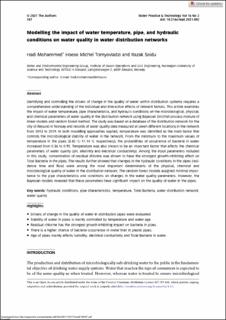| dc.contributor.author | Mohammed, Hadi | |
| dc.contributor.author | Tornyeviadzi, Hoese Michel | |
| dc.contributor.author | Seidu, Razak | |
| dc.date.accessioned | 2022-10-27T09:34:38Z | |
| dc.date.available | 2022-10-27T09:34:38Z | |
| dc.date.created | 2021-01-25T11:13:15Z | |
| dc.date.issued | 2021 | |
| dc.identifier.citation | Water practice and technology. 2021, 16 (2), 387-403. | en_US |
| dc.identifier.issn | 1751-231X | |
| dc.identifier.uri | https://hdl.handle.net/11250/3028594 | |
| dc.description.abstract | Identifying and controlling the drivers of change in the quality of water within distribution systems requires a comprehensive understanding of the individual and interactive effects of relevant factors. This article examines the impact of water temperature, pipe characteristics, and hydraulic conditions on the microbiological, physical, and chemical parameters of water quality in the distribution network using Bayesian Dirichlet process mixture of linear models and random forest method. The study was based on database of the distribution network for the city of Ålesund in Norway and records of water quality data measured at seven different locations in the network from 2013 to 2019. In both modelling approaches applied, temperature was identified as the main factor that controls the microbiological stability of water in the network. From the minimum to the maximum values of temperature in the pipes (3.35 °C–11.14 °C respectively), the probabilities of occurrence of bacteria in water increased from 0.36 to 0.95. Temperature was also shown to be an important factor that affects the chemical parameters of water quality (pH, alkalinity and electrical conductivity). Among the input parameters included in this study, concentration of residual chlorine was shown to have the strongest growth-inhibiting effect on Total Bacteria in the pipes. The results further showed that changes in the hydraulic conditions in the pipes (residence time and flow) were among the most important determinants of the physical, chemical and microbiological quality of water in the distribution network. The random forest models assigned minimal importance to the pipe characteristics and conditions on changes in the water quality parameters. However, the Bayesian models revealed that these parameters have significant impact on the quality of water in the pipes. | en_US |
| dc.language.iso | eng | en_US |
| dc.publisher | IWA Publishing | en_US |
| dc.rights | Navngivelse 4.0 Internasjonal | * |
| dc.rights.uri | http://creativecommons.org/licenses/by/4.0/deed.no | * |
| dc.title | Modelling the impact of water temperature, pipe, and hydraulic conditions on water quality in water distribution networks | en_US |
| dc.title.alternative | Modelling the impact of water temperature, pipe, and hydraulic conditions on water quality in water distribution networks | en_US |
| dc.type | Peer reviewed | en_US |
| dc.type | Journal article | en_US |
| dc.description.version | publishedVersion | en_US |
| dc.source.pagenumber | 387-403 | en_US |
| dc.source.volume | 16 | en_US |
| dc.source.journal | Water practice and technology | en_US |
| dc.source.issue | 2 | en_US |
| dc.identifier.doi | 10.2166/wpt.2021.002 | |
| dc.identifier.cristin | 1878244 | |
| cristin.ispublished | true | |
| cristin.fulltext | original | |
| cristin.qualitycode | 1 | |

